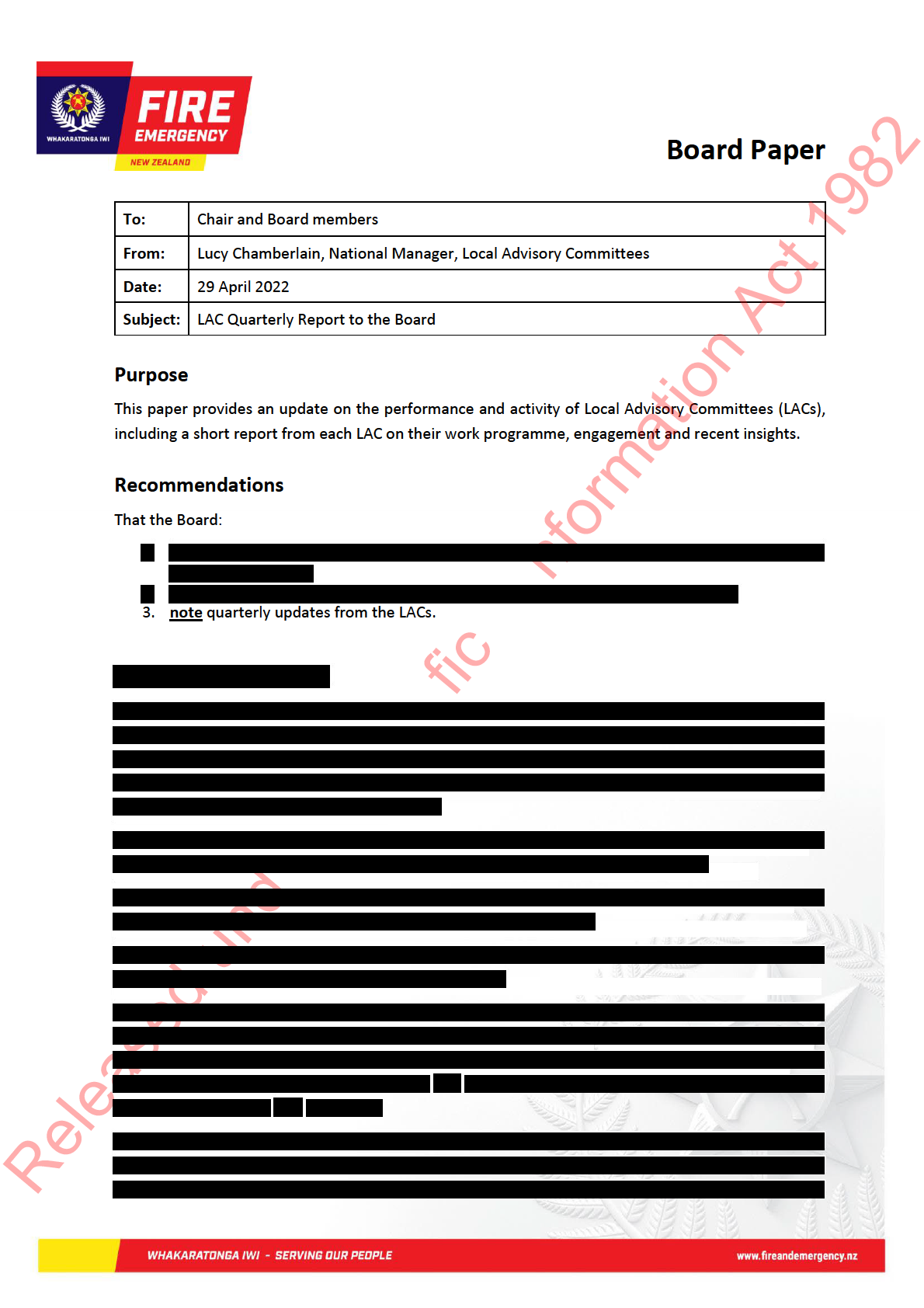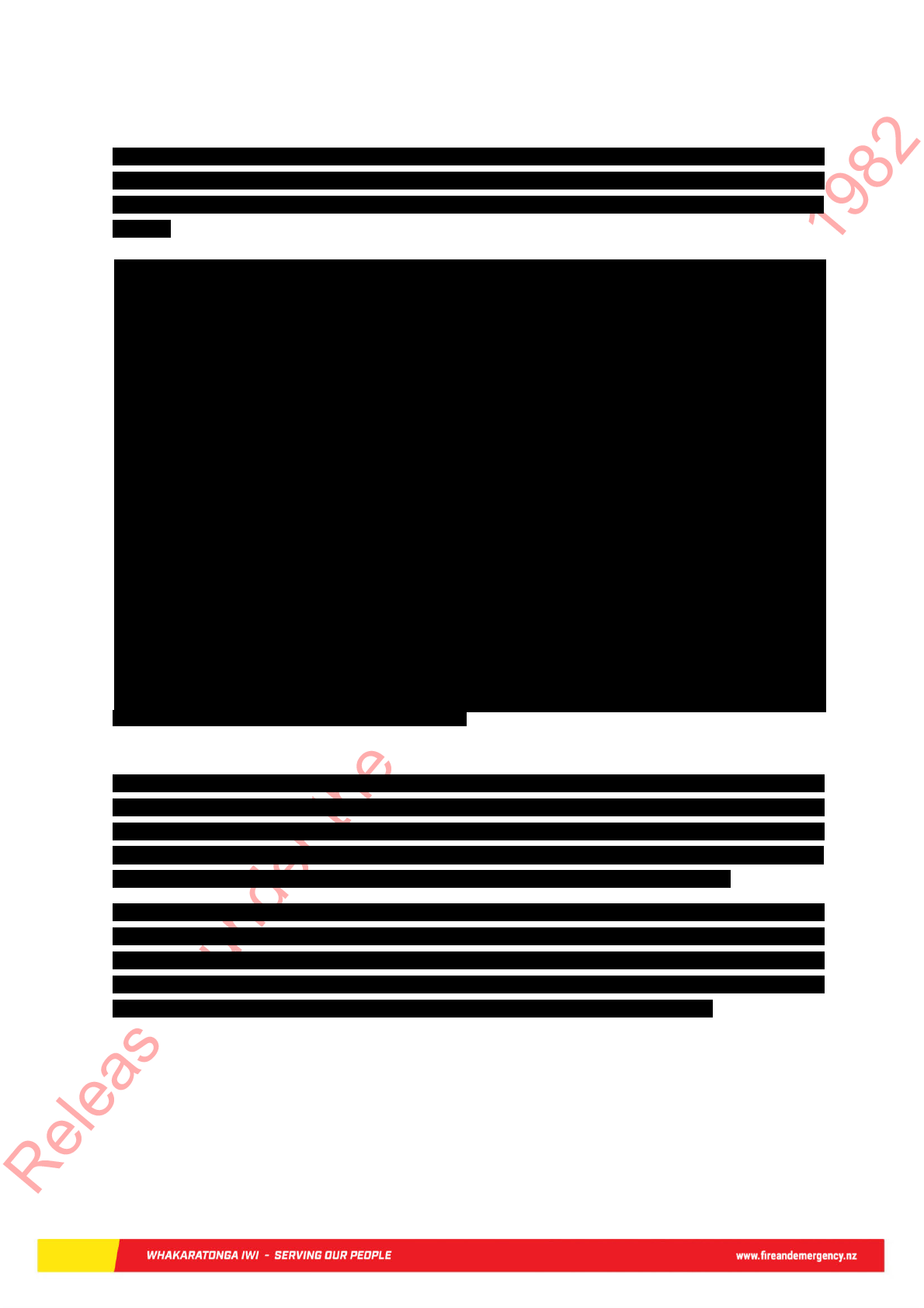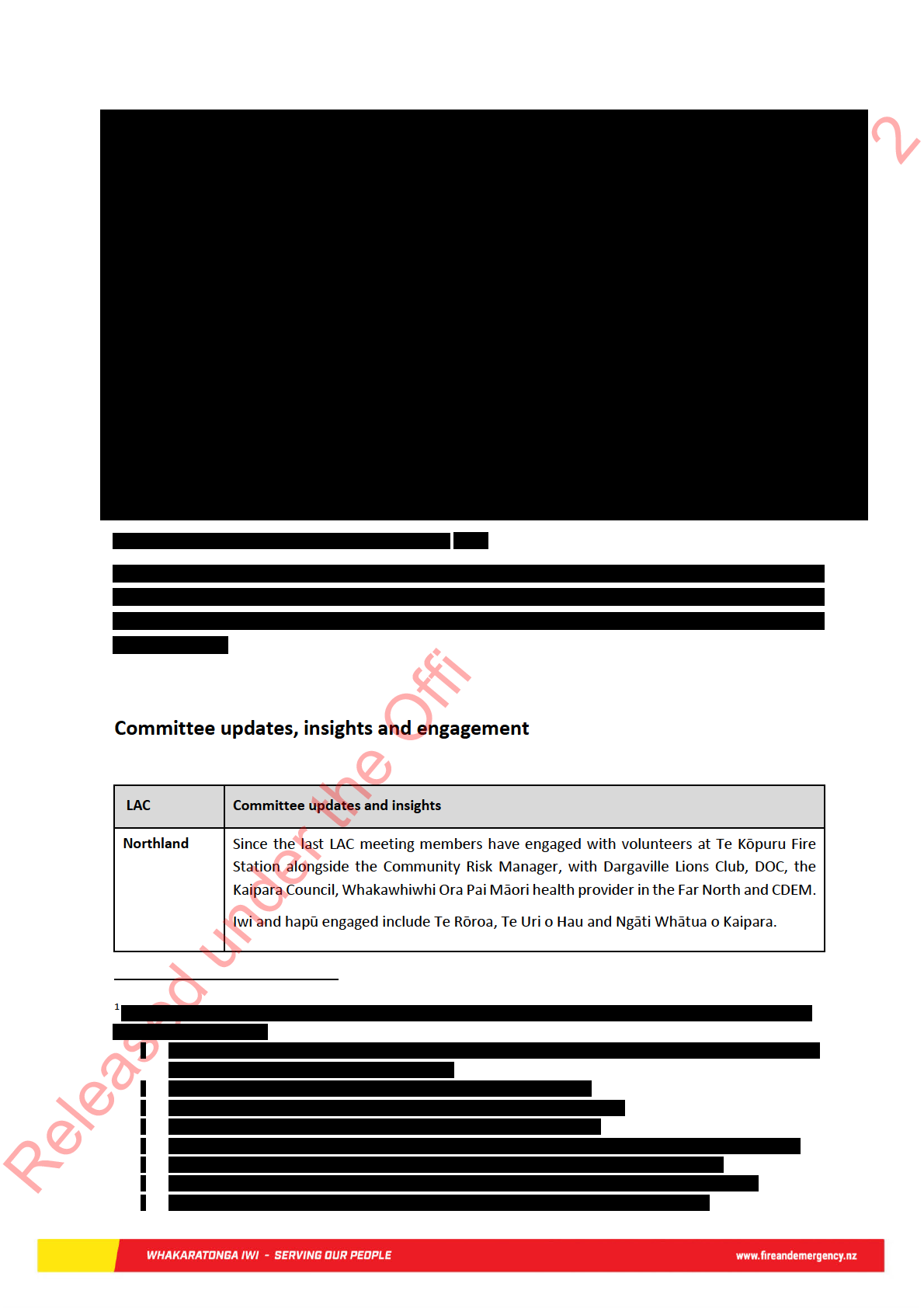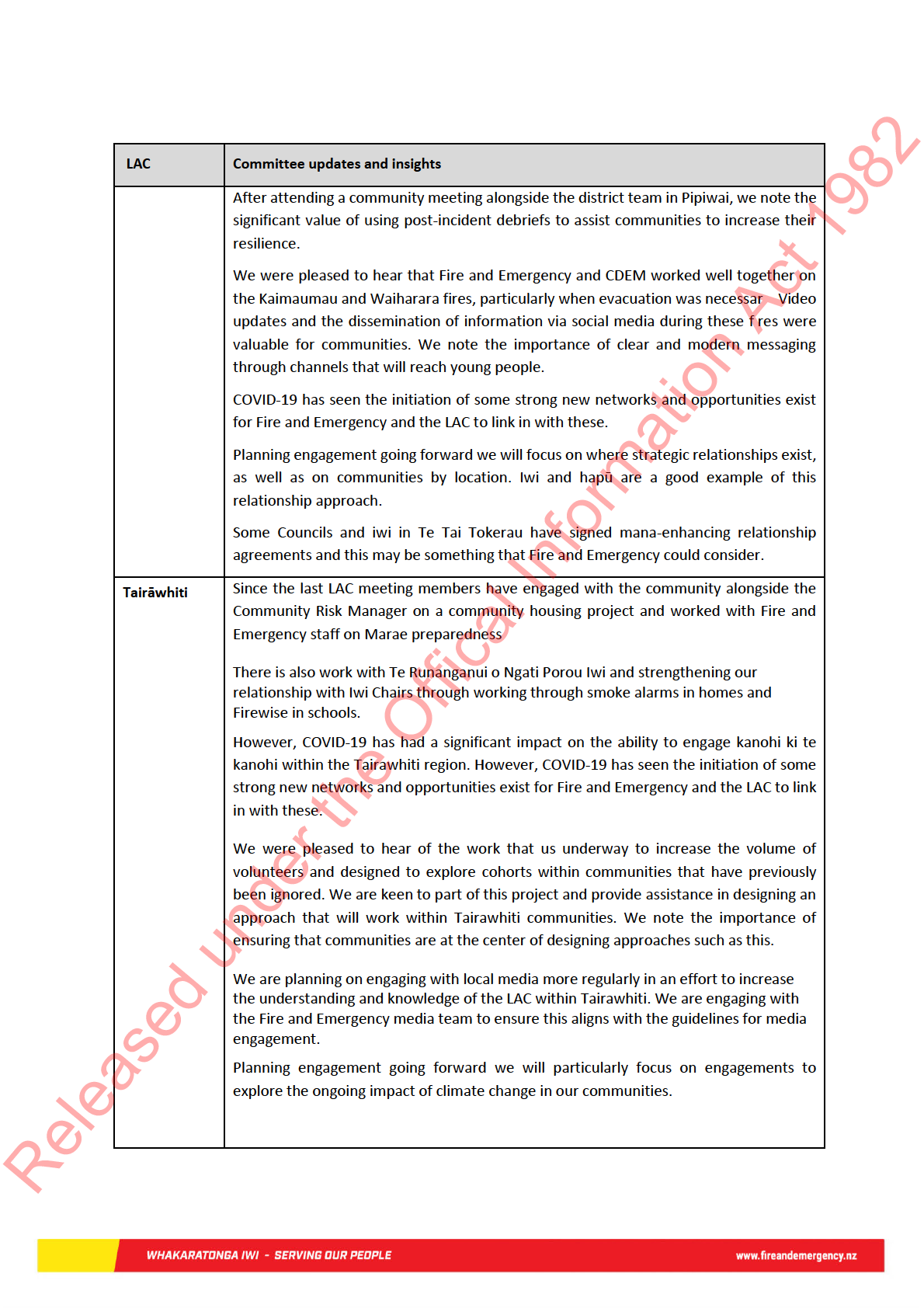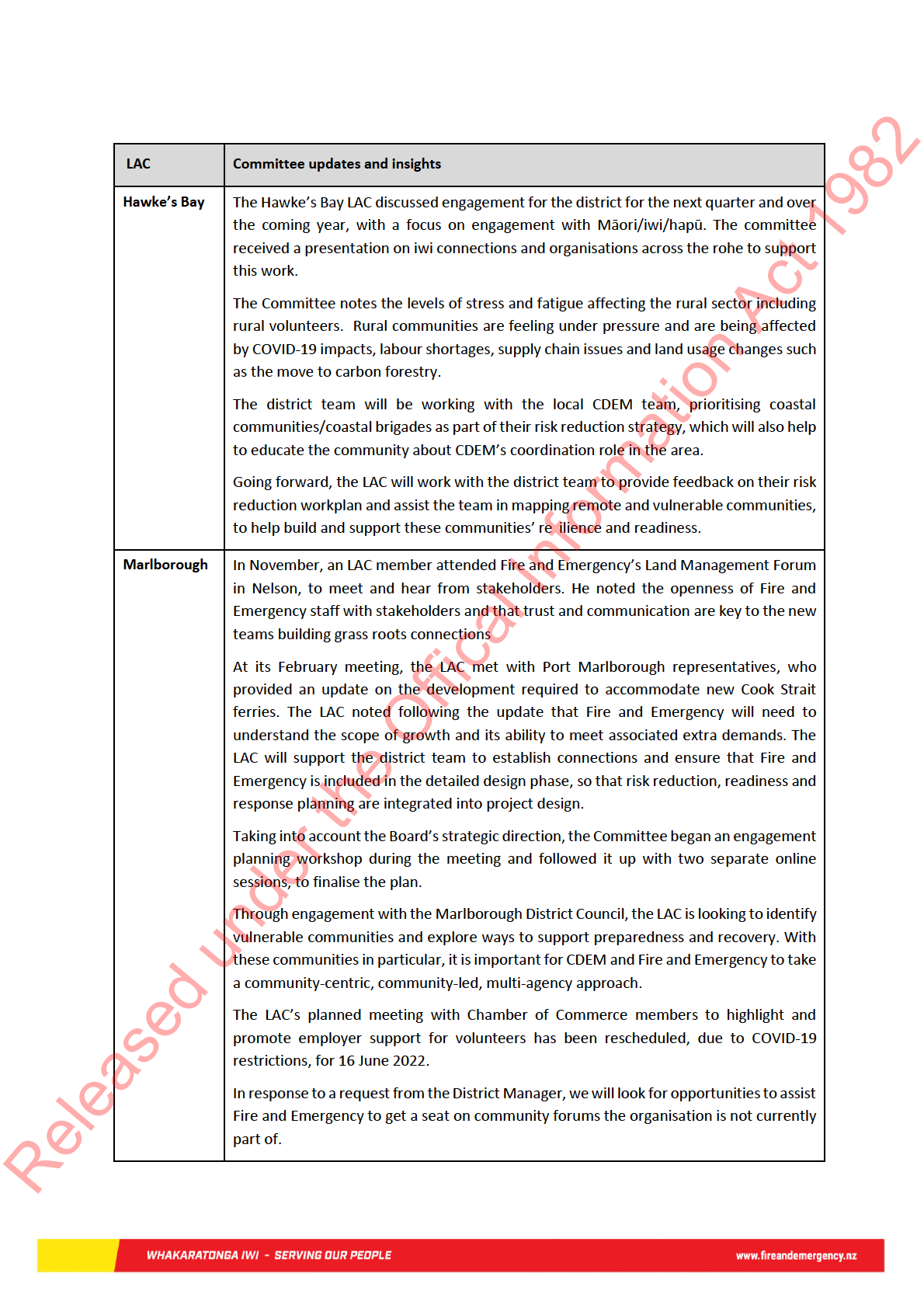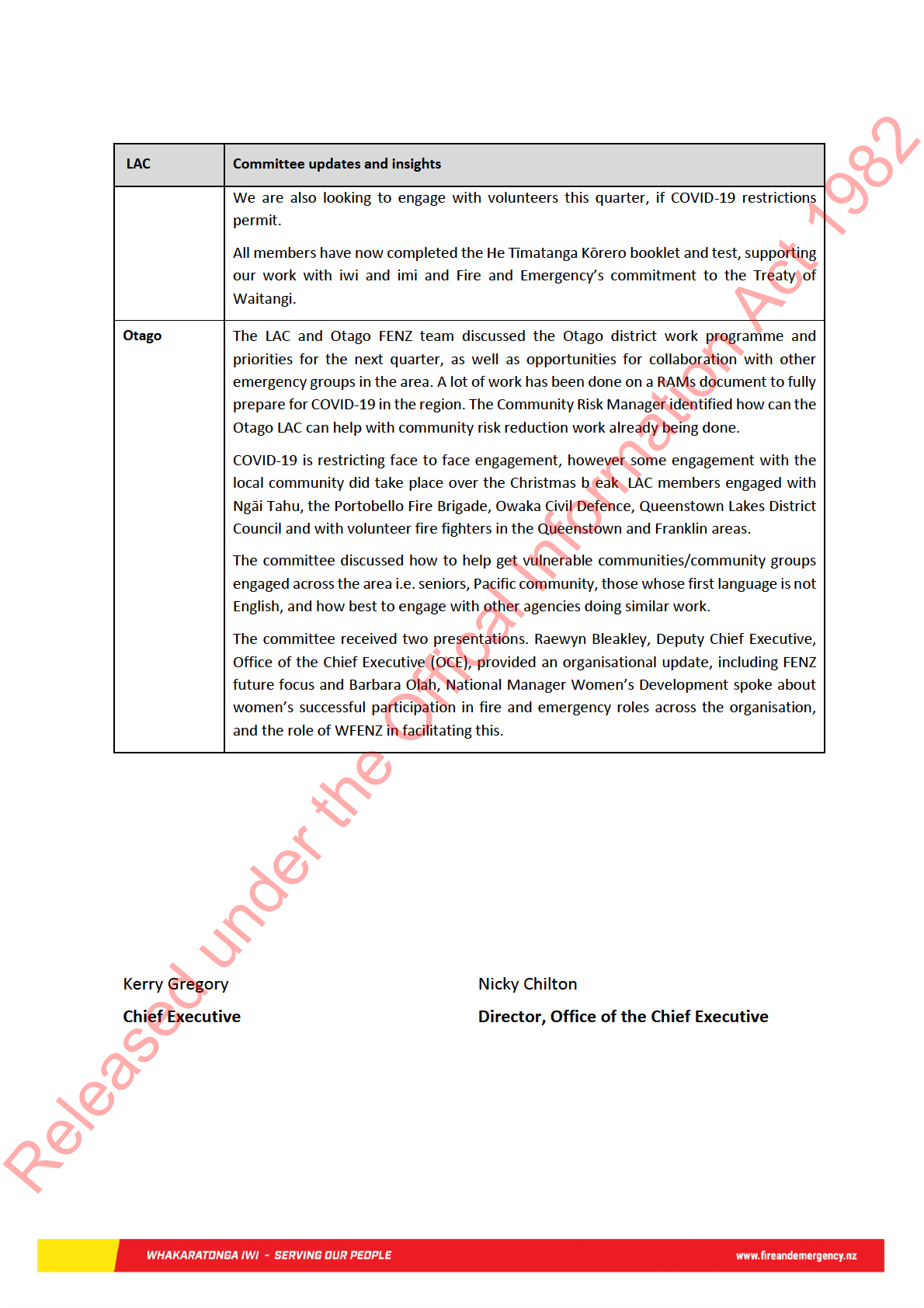 Northland Local Advisory Committee
Northland Local Advisory Committee
Quarterly Report to Fire and Emergency Board
2021-22 Quarter 1
The Northland Local Advisory Committee (LAC) met on 27 February at Kaikohe Fire Station, with the
incoming District Manager (currently Area Manager, Muri Whenua).
It was useful to meet with the Civil Defence Emergency Management (CDEM) team during our meeting
and to hear about their work and cooperation with Fire and Emergency, both cur ently and in the future.
Community engagement
Since the last LAC meeting, members have met with Te Iwi o Roroa. Emergency response is a priority for
this iwi living in and around the Waipoua. As a result of the meeting the community will carry out their
own GAP analysis.
Members engaged with Ngāti Wai, other iwi and hapū and government agencies at a pōwhiri at Mōkau
Marae in Whangaruru, where the wharenui has been rebuilt after a fire incident.
We also engaged with Fire and Emergency and St Johns volunteers in the Hokianga town of Kohukohu.
Many young people leave for larger centres to work and drugs and alcohol are a barrier to volunteering
for some. Older people in the community have skills to contribute and we see value in a volunteer
attraction campaign in the Hokianga. Fire and Emergency’s Volunteer Resilience Team is considering a
visit to the area in early 2022.
We were pleased to hear that the five-week Youth and Cadet training programme developed in
Northland by Police, St Johns, Fire and Emergency and the Northland Regional Council is providing
volunteer training for young people in emergency services. The two industry brigades in the north have
been supportive in providing facilities and equipment for this programme.
At a regular Kaipara Police-Iwi Liaison meeting, iwi noted that they would like more engagement from
agencies at marae level. The LAC will continue to attend these hui, providing updates and identifying
opportunities for partnership in communities.
under the Offical Information Act 1982
Some quite major local government changes are being progressed currently – Three Waters and changes
to roading and the Unitary Authority. There is some concern about the effects of centralisation on
outlying communities. We will maintain a watching brief on these, with Fire and Emergency planning in
mind.
Following a fatal house fire in Taemaro Bay, members of the Taupō Bay Fire Brigade supported by Area
Fire Risk Management staff and Te Hiku’s Pou Takawaenga visited multiple homes in the bay, providing
fire safety advice and installing smoke alarms to reduce the risk to the community.
Released
1

This project was then replicated for the residents of Waimahana, a Far North community the LAC
connected Fire and Emergency with, and in the near future will be offered to the Taupō Bay area. The
relationships developed between staff and the community will be very valuable going forward CDEM
were also able to provide advice in relation to the threat of tsunami and flooding, which both
communities are susceptible to. Working together with CDEM allowed Fire and Emergency staff to assist
the community to build resilience, giving them the ability to recover more quickly following an incident.
The Far North District Council has deferred implementation of its Significant Natural Areas (SNAs)
programme due to opposition and consideration of things such as the New Zealand Biodiversity
Strategy. We note that although some landowners are trying to involve Fire and Emergency – and the
LAC – in debate on SNAs, the organisation shouldn’t get drawn into the debate.
In the coming year, we will continue our focus on isolated and vulnerable communities, supporting
people who don’t generally have a voice, by connecting them with Fire and Emergency and seeking
partnership and risk reduction opportunities.
We will also make use of Waitangi Day, Field Days and other community events to connect with a broad
cross-section of the community, inform people of the role of the LAC, learn about community needs and
identify engagement opportunities.
Insights and considerations
During our engagement in Kohukohu we heard that volunteering for St Johns and Fire and Emergency
require a lot of training, therefore it is difficu t for people to do both. There may be potential for some
training to be combined, particularly in small communities.
The Committee is considering the best way to capture the outcomes of our engagement and to maintain
the connections and relationships we have initiated. We would like to see the successes and value of
LAC work shared with the organisation but note that this is likely to develop once local planning
mechanisms have been set up.
Priority stakeholders for 2021-22
•
Isolated and vulnerable communities
under the Offical Information Act 1982
•
Iwi/hapū
•
Fire and Emergency Volunteers
•
CDEM/Coordinating Executives Group
•
Health
•
Industry brigades
Released
2
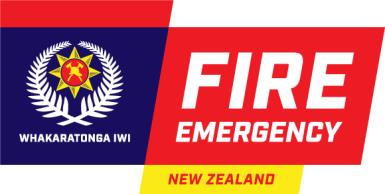 Tairāwhiti Local Advisory Committee
Tairāwhiti Local Advisory Committee
Quarterly Report to Fire and Emergency Board
2021-22 Quarter 1
The Tairāwhiti Local Advisory Committee (LAC) held its fourth meeting at Gisborne Fire Station.
The Regional Manager updated the LAC on the Tranche 2 organisational d strict redeployment
commenting on the new roles and introducing the incoming Tairāwhiti District Manager. The Area
Manager informed the LAC of the marae preparedness meetings with Te Puni Kokiri and the work
involved for LACs to promote the programme when engaging with iwi/hapū.
Community engagement
We set our engagement priorities, working with local leaders to consider district and national priorities.
We will continue our engagement with Māori communities and extend our engagement to include iwi
CEOs, Māori rural health organisations and marae. Members will utilise the korero on the marae
preparedness programme to facilitate conversations with iwi and hapū leaders.
The Committee will engage with local government and Civil Defence to understand what they identify
as district risks and what mechanisms are in place to mitigate these hazards.
To understand how vulnerable groups, perce ve fire and emergency services and their needs to prepare
for emergencies, LAC members will engage with Pasifika, our youth and elderly, and disabled
communities.
We will continue to engage with Fire and Emergency volunteers at their leadership meetings and update
them on LAC work being achieved. Farming entities, such as Federated Farmers and Farming Women
Tairāwhiti, and forestry companies are targeted for engagement to gather insights around community
risks and pathways to volunteerism.
Priority stakeholders for 2021-22
under the Offical Information Act 1982
•
Māo i (iwi, hapū, CEOs, health providers)
•
Forestry
•
Farming entities
•
Multicultural communities
•
CDEM
•
Fire and Emergency Volunteers
Released
3
 Hawke’s Bay Local Advisory Committee
Hawke’s Bay Local Advisory Committee
Quarterly Report to Fire and Emergency Board
2021-22 Quarter 1
The Hawke’s Bay Local Advisory Committee (LAC) held its quarterly meeting at Havelock North Volunteer
Fire Station. The Chief Fire Officer welcomed the LAC to the station and gave an overview of the types
of callouts, volunteer membership, risks and changing demographics in the community.
Community engagement
Members noted at district volunteer leadership meetings, that brigade leaders would like to recruit
more brigade support to assist in the support or prevention space. he LAC has agreed to meet with
elder organisations to publicise volunteering opportunities when engaging with stakeholders.
We attended a Safer Napier hui to introduce the LAC. There is opportunity for Fire and Emergency to
strengthen its relationships with youth-focussed agencies and participate in a youth development
programme which could present volunteer pathways for a younger demographic in the area.
The Committee discussed the risks posed by emergency housing in the district where occupants can end
up residing in temporary accommodation for up to three years. The housing is often not fit-for-purpose
for longer term occupation which can pose fire safety risks. The LAC will engage with accommodation
providers initially to understand the issues and risks involved.
The LAC also identified risks associated with transient and migrant workers living in noncompliant rental
properties. We will engage with these at-risk communities through migrant networks to make these
communities aware of the d strict’s Safety Alarms for Everyone programme and the opportunity for
home fire safety visits.
We have confirmed our engagement plan for the next year. Our focus for engagement aligns with district
priorities and the LAC will engage with stakeholders and networks to gather information and
connections to e fectively support district leadership and planning.
under the Offical Information Act 1982
Insights and considerations
The Committee noted the number of reforms currently being undertaken at a local and national level.
We see benefit in understanding how these reforms, such the local government reforms, Three Waters
proposal and changes to the Resource Management Act, may impact Fire and Emergency.
Volunteers commented that the length of time taken to train recruits can lead to new members leaving
the brigade affecting response capability. There may be an opportunity for Fire and Emergency to
consider how it can provide training to new recruits in a more timely way to improve retention rates.
Released
4
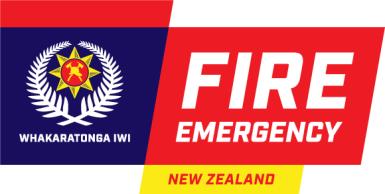
The Committee noted the commitment of Fire and Emergency to Māori and the focus on strengthen ng
engagement with Māori communities. We note the level of resource needed to support this work, such
as Pou Takawaenga Māori and consider that current resource may be inadequate to meet this need
Priority stakeholders for 2021-22
•
Māori communities
•
Transient and migrant communities
•
Pasifika
•
Older populations
•
Youth
•
Local government
•
Forestry
•
Fire and Emergency volunteers
under the Offical Information Act 1982
Released
5
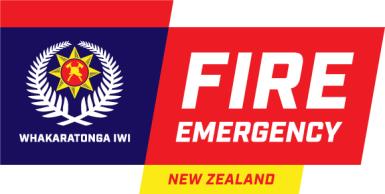 Marlborough Local Advisory Committee
Marlborough Local Advisory Committee
Quarterly Report to Fire and Emergency Board
2021-22 Quarter 1
The Marlborough Local Advisory Committee (LAC) met on 13 July at the Emergency Operations Centre
in Blenheim, with members of the Te Ihu Regional Team (RLT).
The RLT update included the latest recruitment for stand-up of the new district teams on 27 September
and changes to the management of rural fire across the top of the South Island. Local leaders also
expressed appreciation for LAC members’ feedback on the Fire Plan and noted that they have received
positive feedback on the Committee’s engagement with volunteers.
Community engagement
Engagement with volunteers has progressed well since the last LAC meeting. Members attended events,
such as the Northbank and Rai Valley station openings and met with a variety of groups and individual
volunteers, including the Chief Fire Officer of the Blenheim Brigade. We will continue with volunteer
engagement, using the Volunteer Strategy outcomes as a guide.
Extending our volunteerism deep dive, we have organised four evening events for engagement with
employers of volunteers for August and September. These meetings will be held at fire stations across
the LAC district, so that employers can choose the most suitable venue and time.
During the LAC meeting we received a presentation from the Operations Manager of Te Kotahi o Te
Tauihu Charitable Trust, a former iwi Chair who has developed a draft Civil Defence Strategy for the
eight Te Tauihu iwi (2021-2025) In Marlborough, Civil Defence has funded marae to put together
emergency management plans but she noted that there is potential for the LAC and for Fire and
Emergency to support marae with compliance and risk reduction.
Iwi would like to see a consistent emergency response across the region, rather than division between
Marlborough and Nelson/Tasman.
We also had the opportunity to explore with her the best way forward for LAC engagement with iwi. Iwi
under the Offical Information Act 1982
are currently highly committed. Due to the pressure for iwi to engage with a variety of agencies and
organisations, and their focus on the growth of their economic and social base, the LAC will postpone
engagement for the next few months, until the Community Risk Team is set up.
One LAC member will then lead engagement, meeting with General Managers to start with. To avoid
duplication, LAC engagement will be undertaken alongside the District Community Risk team. There may
also be opportunities for introductory engagement with iwi stakeholders at existing events.
Released
6
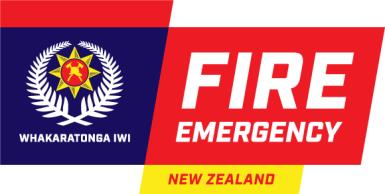 Insights and considerations
Insights and considerations
The Committee noted that there may be an opportunity for older volunteers who may not wish to
respond to emergencies, to support risk reduction work.
Volunteers raised with us the fact that there is no standardisation of employer policies to support
volunteers. For example, when dealing with fatalities, some volunteers receive paid leave – others do
not. There may be an opportunity for Fire and Emergency to share with employers’ specific options in
this regard, or to formalise a protocol for employers to agree to.
Priority stakeholders for 2021-22
•
Iwi
•
Volunteers
•
Employers of volunteers
•
Community
under the Offical Information Act 1982
Released
7
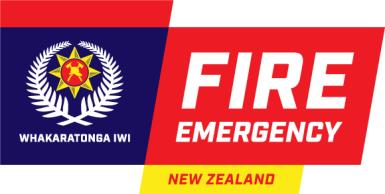 West Coast Local Advisory Committee
West Coast Local Advisory Committee
Quarterly Report to Fire and Emergency Board
2021-22 Quarter 1
The West Coast Local Advisory Committee (LAC) met at Greymouth Fire Station on 16 July with members
of the Te Ihu Regional Leadership Team (RLT). The meeting coincided with the extreme weather event
that caused flooding and damage on the West Coast, so our local leaders were largely occupied with
that.
As a committee we want to acknowledge Paul Swain’s contribution as Fire and Emergency Chair during
the establishment of the first seven committees. We welcome Rebecca Keoghan’s appointment to the
role of Chair, particularly as she is from the West Coast. We would like to extend an invitation to Rebecca
to attend one of our LAC meetings.
Community engagement
Since the last LAC meeting we have met with volunteer representatives from Hokitika, Ross, Kumara and
Greymouth, at a volunteer forum similar to those undertaken in the past few months.
Volunteers commented on a shortage of cleaning facilities at some brigades, meaning they return home
dirty after callouts, causing volunteers to feel less than appreciated.
The engagement we had planned in South Westland was postponed. The timing for this was not ideal,
as stakeholders had recently been brought together by Fire and Emergency local leaders. We are keen
to extend our engagement into this area and will arrange engagement with businesses in South
Westland this quarter, to coi cide with a business forum related to the government support package
for companies affected by COVID-19.
The incoming District Manager’s priority is to build relationships in the first few months. We will
therefore work with him to plan LAC engagement timelines, and schedule joint meetings where
appropriate, to avoid duplication and stakeholder confusion.
We will work alongside the new Community Risk Team on Education, engaging with schools and young
under the Offical Information Act 1982
peoples’ groups, with volunteer sustainability in mind. We also have an interest in contributing to any
review of Fire and Emergency’s MOU with the Ministry of Education, to assist with potential addition of
content relating to the alignment of strategic priorities - specifically, building resilient communities
through education.
Released
8
 Insights and considerations
Insights and considerations
Hokitika volunteers noted that their recruitment is going particularly well – the brigade has a waiting
list. We observed that the reputation of brigade leaders is an important factor in attracting volunteers,
but also suggest that a case study could be undertaken to identify what is working well here.
We heard feedback on the professional development of senior leaders - that brigade chiefs and senior
officers would like more refresher training. They are always keen to hear about operational changes
from recruits returning from Rotorua, but a better mechanism to let senior leaders know what has
changed would be helpful.
We were interested to hear about the framework Fire and Emergency is deve oping to integrate LAC
advice into the planning and strategy into the organisation, in particular the feedback loops to LACs. The
Committee had an extended discussion about the ways in which feedback could be provided to
communities and would like Fire and Emergency to consider this as the details are worked out.
We would also appreciate assurance that the local nature of advice to the Board and Fire and Emergency
will be retained.
Priority stakeholders for 2021-22
•
Fire and Emergency Volunteers
•
Iwi
•
Educations (Youth/Schools)
•
Civil Defence Emergency Management
•
Industry and small and medium enterprises – including farming, tourism and larger dairy,
forestry and mining employers
under the Offical Information Act 1982
Released
9
 Chatham Islands Local Advisory Committee
Chatham Islands Local Advisory Committee
Quarterly Report to Fire and Emergency Board
2021-22 Quarter 1
The Chatham Islands Local Advisory Committee (LAC) met at Te Ūpoko Region Headquarters on
5 August, with members of the Te Ūpoko Regional Leadership Team (RLT).
We were pleased to hear about the appointment of Fire and Emergency’s new Chair and that Tranche 2
recruitment is progressing rapidly. The LAC looks forward to welcoming the new District Manager to the
Chatham Islands in November.
Community engagement
Since our last meeting we have engaged with community health and social service provider, Ha o Te Ora
o Wharekauri Trust. At this meeting, the Trust noted that community home fire safety training including
the use of fire extinguishers would be useful, and emphasised the importance of a variety of fire safety
communications materials.
During the meeting with Ha O Te Ora we were asked to explain the meaning of fire sirens on the Island.
RLT have clarified the triggers for first, second and third alarms and we asked them to include this
information in the fire safety brochure they are producing for the Chatham Islands.
The brochure is part of the Home Fire Safety Visit project led by Te Upoko’s Fire Risk Management
Officer. Fire and Emergency’s Communications team will produce a video and other collateral
highlighting how the people of the Chatham Islands can work together as a community to reduce fire
risk and to demonstrate the importance of building community resilience.
Tranche 2 changes have delayed this work in partnership with iwi and imi to distribute smoke alarms
and increase fire safety communication, but the programme is now planned for September and will
include one day on Pitt Island.
The Committee is arranging meetings with four key stakeholders in November, to coincide with our next
LAC meeting and the time when RLT members are on the Islands. Ngāti Mutunga o Wharekauri Iwi Trust,
under the Offical Information Act 1982
Hokotehi Moriori Trust, Chatham Islands Enterprise Trust and the Chatham Islands Council, are all
stakeholder with whom we have agreed to meet regularly, due to their importance and influence on
the Islands.
We confirmed our engagement plan for the coming year, reducing our list of key stakeholders to those
with the broadest mandate and targeting established forums to engage with as many as possible in the
community.
Released
10
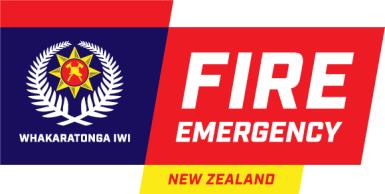 Insights and considerations
Insights and considerations
At the meeting with Ha O Te Ora, interest was expressed in CIMS training for members f the
community, so that more people understand the structure and can better assist during emergency
events. This suggestion has been conveyed to local leaders, for follow up with CDEM.
Priority stakeholders for 2021-22
•
Iwi / Imi
•
Chatham Islands Council
•
CI Enterprise Trust
•
Community Groups
•
Fire and Emergency Volunteers
under the Offical Information Act 1982
Released
11
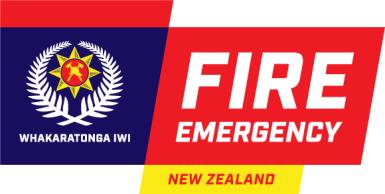 Otago Local Advisory Committee
Otago Local Advisory Committee
Quarterly Report to Fire and Emergency Board
2021-22 Quarter 1
The Otago Local Advisory Committee (LAC) held its quarterly meeting at Naseby Volunteer Fire Station.
The Deputy Chief Fire Officer (DCFO) greeted the LAC and gave an overview of the district risks, volunteer
membership and the make-up of the community. The DCFO is also a representative of the forestry sector
and provided an outline of processes and risks associated with forest operations.
LAC members were encouraged to hear of the amalgamation of the Ranfurly brigade with the Maniototo
component of the Blackstone brigade. We understand this merger will enable more volunteers to offer
a broader skillset, to better respond to and support local communities
Community engagement
An LAC member engaged with Pasifika groups in Oamaru to understand their risks and needs and to
support the local brigades to connect with Pasifika g oups to develop a relationship and build resilience
and fire safety awareness amongst this community.
A Committee member introduced the LAC purpose and role to Safer Waitaki and Network Waitaki. There
is an opportunity for Fire and Emergency to collaborate with these groups to organise a community-
based event to enhance fire safety awareness and promote volunteerism in the Waitaki district. It would
be an effective way to meet and engage with several organisations in one setting. Engagement will
continue with both entities to further understand community needs and priorities.
An LAC member met with the Royal Albatross Centre to understand their risks on the peninsula and
identified a need for developing an evacuation plan which Fire and Emergency will assist with developing
to improve their emergency preparedness.
The Committee noted the shortage of suitable housing available in North Dunedin and increase of
itinerant workers coming into the area. There may be an opportunity for Fire and Emergency to increase
their risk reduction work in this part of the city.
under the Offical Information Act 1982
LAC members discussed with Regional Leadership Team (RLT) members the level of engagement with
volunteers and whether information reported back was useful for them. RLT encouraged members to
cont nue meeting volunteers at leadership meetings with a focus on discussing community risks and
pathways to volunteerism.
After careful consideration of the previous year’s engagement, the Committee agreed to continue with
its three priority groups, mana whenua, Fire and Emergency volunteers, and vulnerable communities.
Valuable links have been made and built upon and more focused work will continue to gather and report
their interests, local risks and issues.
Released
12
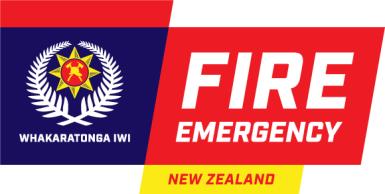 Insights and considerations
Insights and considerations
The Committee appreciate the work in developing the framework to include LAC advice into Fire and
Emergency. To help the Committee focus on specific areas for future engagements, we look forward to
receiving more direction from the Board on strategic priorities.
High fire risk as the result of urban development in previously rural areas remains an issue of concern.
The LAC noted the significant need for Fire and Emergency to submit on issues and risks to resource
consent planning processes at an early stage and insist for conditions to be included w thin the consent
that include fire mitigation. As subject matter experts, Fire and Emergency have an important role to
play in ensuring risk reduction is considered when planning new developments.
The Otago LAC suggested a nationwide conference of all LACs. The purpose would be for members to
receive an update on Fire and Emergency’s strategy and to share learnings across all the LACs.
Priority stakeholders for 2021-22
•
Mana whenua
•
Vulnerable communities
•
Fire and Emergency volunteers
•
Local Government
under the Offical Information Act 1982
Released
13


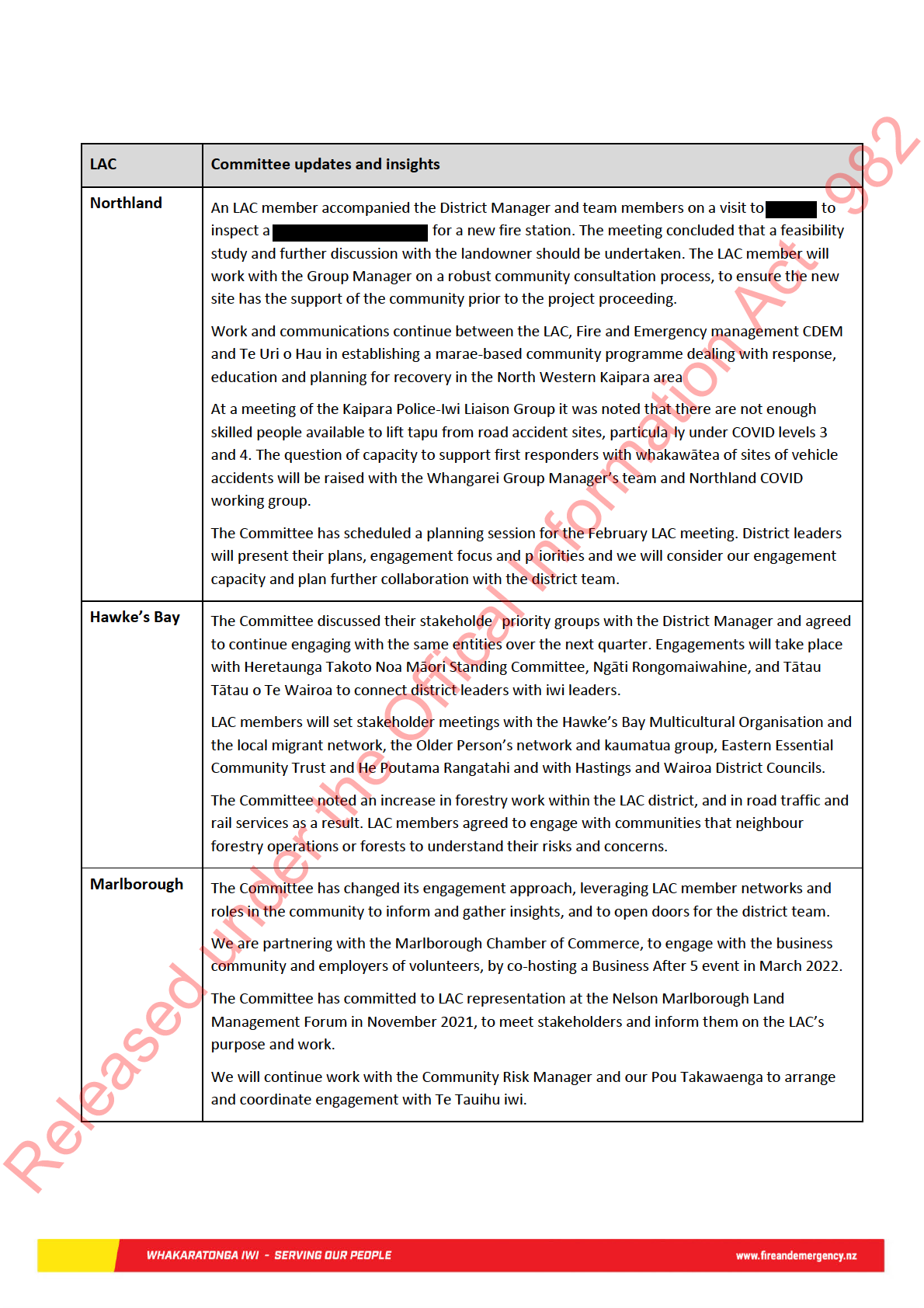
 West Coast
West Coast
The COVID-19 lockdown in September resulted in the cancellation of a business forum with
agencies and volunteer engagement the Committee had planned for South Westland. We are
however aiming to meet with South Westland businesses in November.
The Committee agreed to a change of strategy with relation to engagement with volunteers,
moving away from the brigade forums we met with last year. In partnership with the district
team we are planning a series of events to recognise volunteers and promote volunteerism with
employers.
The District Manager will discuss with Buller Council’s Recovery Manager what LAC engagement
might be useful around the July 2021 flood. The Committee would like to understand the
community’s level of resilience and what the main issues were. Development West Coast’s
survey on the impacts of the flood on businesses will provide a useful overview of the effects on
industry and SMEs.
We are looking to schedule second meetings with the two hapū in the LAC District, Kāti Waewae
and Kāti Māhaki ki Makaawhio, in the new year.
Otago
The Committee was pleased to learn of the District Manager’s priorities and encouraged him to
utilise members to help connect Fire and Emergency district leaders with community groups and
individuals.
Following engagement with vulnerable community groups, we noted an opportunity for the
development of fire safety material, aimed at migrant communities, that could be distributed
nationally.
As members approach the mid-point of their tenure, they noted that it may be timely to review
the LAC Terms of Reference and that they would be willing to contribute to a review.
under the Offical Information Act 1982
Rhys Jones
Raewyn Bleakley
Chief Executive
Deputy Chief Executive, Office of the Chief Executive
Released
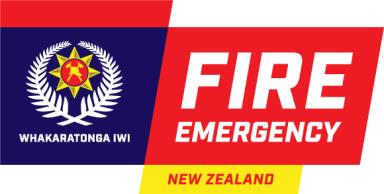
Chatham Islands and Tairāwhiti LACs’ Board reports were not included in the consolidated LAC report to the
Board in December. Their quarter 2 meetings were delayed, to allow for the induction of new members.
Tairāwhiti Local Advisory Committee
Quarterly Report to Fire and Emergency Board
2021-22 Quarter 2
Committee updates and insights
The Tairāwhiti LAC welcomed its four new members at the Committee’s quarter 2 meeting on 23
November. The Committee is working to understand the strengths and the opportunities members
bring and plan efficient and cooperative community engagement
The Committee is keen to support Fire and Emergency’s current activities to help build resilience in
communities. LAC members will support the district team to approach and get to know
communities in their rohe they are less familiar with.
The Committee’s engagement will be planned according to Fire and Emergency’s most relevant
strategic priorities,
Building resilient communities and
Collaboration, partnerships and influence.
Chatham Islands Local Advisory Committee
Quarterly Report to Fire and Emergency Board
2021-22 Quarter 2
Committee updates and insights
The Chatham Islands LAC was pleased to welcome two new members to our meeting on 9
December. The Committee received a presentation on Hiwa-i-te-Rangi and members will, in their
own time, complete the He Tīmatanga Kōrero booklet and test, to support our work with iwi and
imi.
under the Offical Information Act 1982
The introduction of cell phone coverage to the Chatham Islands provides new opportunities for Fire
and Emergency in terms of the distribution of information and capture of data. Communications
Centre (ComCen) mapping for the Chatham Islands went live in December, allowing Centre staff to
pinpoint the locations of emergency incidents and resolving an issue we flagged during our visit to
the ComCen in August.
The LAC will engage with its four key stakeholders in early March. In addition to Hokotehi Moriori
Trust, Ngāti Mutunga o Wharekauri Iwi Trust, Chatham Islands Council and Chatham Islands
Enterprise Trust, members will make contact with Air Chathams and the Chatham Islands Airport
Released
company.
Local Advisory Committees – Quarter 2 Board Reports – February 2022
